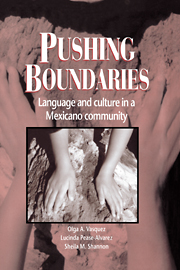Book contents
- Frontmatter
- Contents
- Foreword
- Preface
- Chapter 1 INTRODUCTION
- Chapter 2 EASTSIDE: A MEXICANO COMMUNITY
- Chapter 3 HOME AND SCHOOL CONTEXTS FOR LANGUAGE LEARNING
- Chapter 4 BILINGUAL CHILDREN CROSSING CULTURAL BORDERS
- Chapter 5 NEGOTIATING CULTURE AND LANGUAGE IN THE HOME
- Chapter 6 MOVING TOWARD A RECOGNITION PERSPECTIVE
- Chapter 7 MEETING THE CHALLENGES OF DIVERSITY
- Notes
- References
- Index
Foreword
Published online by Cambridge University Press: 26 March 2010
- Frontmatter
- Contents
- Foreword
- Preface
- Chapter 1 INTRODUCTION
- Chapter 2 EASTSIDE: A MEXICANO COMMUNITY
- Chapter 3 HOME AND SCHOOL CONTEXTS FOR LANGUAGE LEARNING
- Chapter 4 BILINGUAL CHILDREN CROSSING CULTURAL BORDERS
- Chapter 5 NEGOTIATING CULTURE AND LANGUAGE IN THE HOME
- Chapter 6 MOVING TOWARD A RECOGNITION PERSPECTIVE
- Chapter 7 MEETING THE CHALLENGES OF DIVERSITY
- Notes
- References
- Index
Summary
A few weeks before reading this book, I visited my good friend and colleague Pedro Pedraza in New York City, actually in East Harlem, well known as Spanish Harlem, or “E1 Barrio” Pedro, a sociolinguist, had mentioned the possibility of developing an ethnographic study of Mexicans in East Harlem. That's right, Mexicans. In the last four years or so he had noticed an appreciable number of Mexicans in what is predominantly a Puerto Rican, and, more recently, a Dominican community. One could spot young Mexican families, parents and children, walking in the neighborhood, street-corner vendors selling what one could identify as Mexican wares, and Mexican men and women working in the local shops. A teacher in a nearby school had told Pedro that she had received some new students from Mexico, mostly from Puebla, in central Mexico, and there were now bodegas where one could purchase Mexican products and eat Mexican food with a distinctive estilo from Puebla, and we noticed that these places were becoming the primary centers of interaction for the newcomers. In short, all the signs were there indicating the rapid incorporation of a new ethnic group into E1 Barrio. But why? Why East Harlem in New York City? And how are these immigrants making out in these difficult circumstances? How are they learning English? What are the children experiencing in school?
- Type
- Chapter
- Information
- Pushing BoundariesLanguage and Culture in a Mexicano Community, pp. ix - xiiPublisher: Cambridge University PressPrint publication year: 1994

